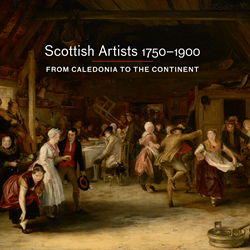
Scottish Artists
A collection of works by Scottish Artists collected by British monarchs from George III to the present day.
SIR DAVID WILKIE (1785-1841)
The Penny Wedding
Signed and dated 1818Oil on panel | 65.1 x 95.6 cm (support, canvas/panel/str external) | RCIN 405536
David Wilkie was one of the most successful painters of the Regency period and was greatly encouraged by the Regent. Born in Fife, trained in Edinburgh, Wilkie settled in London in 1805 and began regularly exhibiting at the Royal Academy small scale scenes of everyday life. At this time old master genre painting was hugely popular and expensive, as is demonstrated by the many examples of the work of Teniers and van Ostade (Adriaen and Isaac) collected at this time by George IV. Wilkie consciously emulated these low-life scenes, charging similarly high prices, but the meaning of his work shifts with the tide of British culture in the later eighteenth century towards a more celebratory (some would say sentimental) treatment of ordinary people. Teniers painted ‘peasants’; Wilkie painted the ‘the salt of the earth’. Wilkie’s royal career involved succeeding Raeburn as Limner to the King in Scotland in 1823 and Lawrence as Principal Painter in Ordinary to the King in 1830; he remained in these positions until his death, although Queen Victoria disliked his work.
In 1813 at a Royal Academy dinner the Prince Regent asked Wilkie to paint a companion to the ‘Blind-Man’s Buff' (OM 1175, 405537) already in his collection. This picture had itself been painted as a pair to Edward Bird’s ‘Country Choristers’ (OM 685, 405540) and hung with it in the ‘Upper Anti Room’ at Carlton House. This episode suggests that George IV liked groups of closely related paintings, without needing to pair them off two-by-two, something confirmed by many odd-numbered groups in the collection. Wilkie was paid 500 guineas for the work in 1819, the same year that it was exhibited at the Royal Academy. Many drawings exist for individual figures and groups.
Wilkie chose to depict a type of marriage ceremony, common in Scotland, where the guests each paid a penny towards the expenses and anything left over went towards the couple’s new home. The subject was already known, having been treated by David Allen (1744-96) in a painting in Beaverbrook Art Gallery, Fredericton, New Brunswick. The idea of the subject would seem to be that no richer couple could be happier, more loving, gracious and handsome, and no father of the bride could offer hospitality more generous and convivial than this, laid on by the community as a whole. Money certainly couldn’t buy a better fiddler than Niel Gow (1727-1807), clearly recognisable here; Robert Burns’s description of his ‘kind open-heartedness, mixed with unmistrusting simplicity’ would probably sum up Wilkie’s intention in the scene as a whole.
Signed and dated: David Wilkie 1818.’
In 1813 at a Royal Academy dinner the Prince Regent asked Wilkie to paint a companion to the ‘Blind-Man’s Buff' (OM 1175, 405537) already in his collection. This picture had itself been painted as a pair to Edward Bird’s ‘Country Choristers’ (OM 685, 405540) and hung with it in the ‘Upper Anti Room’ at Carlton House. This episode suggests that George IV liked groups of closely related paintings, without needing to pair them off two-by-two, something confirmed by many odd-numbered groups in the collection. Wilkie was paid 500 guineas for the work in 1819, the same year that it was exhibited at the Royal Academy. Many drawings exist for individual figures and groups.
Wilkie chose to depict a type of marriage ceremony, common in Scotland, where the guests each paid a penny towards the expenses and anything left over went towards the couple’s new home. The subject was already known, having been treated by David Allen (1744-96) in a painting in Beaverbrook Art Gallery, Fredericton, New Brunswick. The idea of the subject would seem to be that no richer couple could be happier, more loving, gracious and handsome, and no father of the bride could offer hospitality more generous and convivial than this, laid on by the community as a whole. Money certainly couldn’t buy a better fiddler than Niel Gow (1727-1807), clearly recognisable here; Robert Burns’s description of his ‘kind open-heartedness, mixed with unmistrusting simplicity’ would probably sum up Wilkie’s intention in the scene as a whole.
Signed and dated: David Wilkie 1818.’







